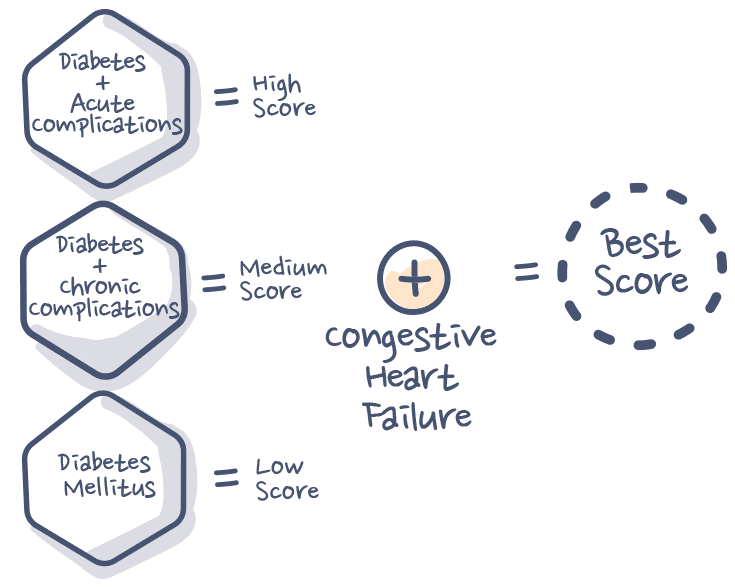Understanding Risk Adjustment
Transforming from a fee-for-service payment model to a value-based model can may seem daunting, the shift can seem confusing. In the long run, the financial benefit and increase in patient engagement, will pay off. Below are answers to commonly asked questions that will help put your mind at ease.
Frequently Asked Questions
About Risk Adjustment
Risk adjustment levels the playing field among health insurers by transferring funds from plans with relatively lower-risk (i.e., young, healthy) enrollees to plans with relatively higher-risk (i.e., old, sick) enrollees. Section 1343 of the Affordable Care Act provides for a permanent risk adjustment program that compensates insurers that disproportionately attract higher-risk populations. Risk adjustment is a form of predictive modeling introduced by the Medicare Modernization Act of 2003. It gauges the risk that a member will incur medical expenses above or below an overall average over a defined period of time. The concept was introduced to minimize the incentive to choose enrollees based on their health status. It is designed to encourage competition among health plans based on quality, efficiency, and premium stabilization.

How does risk coding affect my practice? How does it benefit my practice?
In today’s performance-based payment models, such as the Merit-based Incentive Payment Program (MIPS), providers’ payments are closely tied to their patients’ health outcomes. Providers can’t (ethically) choose their patients, however. Without risk adjustment, providers in disproportionately higher-risk populated areas would receive payment reductions that may not reflect accurately the quality of care they provide. Risk adjustment allows for more accurate comparisons across provider Tax Identification Numbers by removing differences in health and other risk factors that affect measured outcomes not under the provider’s control. Risk coding affects many areas of your practice. Improved documentation and coding, leads to better patient care. Risk coding is the primary means of communicating the patient record for specialty care to health plans and CMS. Accurate documentation also improves quality reporting and efficiency when responding to regulatory requirements, such as HEDIS/QARR reviews and risk-adjusted data validation (RADV) audits. Financially, it helps achieve greater accuracy in the documentation of key quality metrics associated with payments by the Enhanced Primary Care (EPC) program.
How is HCC determined?
The CMS-HCC diagnostic classification system begins by classifying all ICD-10-CM diagnosis codes into diagnostic-related groups (DRG), which represent well-specified medical conditions or sets of conditions. Each code maps to a single DRG. DRGs are further aggregated into Condition Categories (CC), which describe a broader set of similar diseases. CCs are related clinically and with respect to cost. Hierarchies are imposed among related CCs, so that a person is coded for only the most severe manifestation among related diseases. After imposing hierarchies, CCs become Hierarchical Condition Categories (HCC). Because HCCs accumulate, a single individual may be coded for none, one, or more than one HCC.
What impact does unspecified diagnosis coding have on providers and patients?
Accuracy and specificity in ICD-10-CM coding and medical documentation is critical for risk adjustment. ICD-10-CM diagnosis coding is used to represent the member’s health status and establish an accurate risk score. As in all coding, ICD-10-CM diagnoses cannot be inferred from physician orders, nurse notes, or lab or diagnostic tests — they must come from the medical record documentation. Submitting an inaccurate diagnosis, or a diagnosis resulting in a different HCC, is a compliance risk. Any change in the HCC could mean you are receiving too much or too little revenue.
What is a RADV?
- Random CMS RADV uses a selection process in which a Medicare Advantage (MA) plan is randomly selected for an audit.
- Targeted CMS RADV is applied to MA plans who have raised red flags, such as a large increase in risk scores, etc.
Both random and targeted CMS RADV use a “stratified sample,” which is a random sample of one-third of patients with high-risk scores, one-third of patients with medium risk scores, and one-third of low risk scores. The focus is not proving the ICD code, but rather proving the validity of the HCC value that was paid to the health plan by CMS for the reported ICD code.
Mock RADV
This mock audit helps streamline your internal processes for an authentic RADV audit and helps to confirm reported diagnoses and identify ICD-10-CM coding errors. Errors in provider documentation are identified to prevent a negative impact on your overall RAF (Risk Adjustment Factor) score. Identifying missed diagnosis and accurately reporting those additional HCCs in RAPS filings typically result in millions of dollars of incremental revenue.
CONNECT WITH US
Physicians and hospitals nationwide trust AccuMedChart for their medical billing and coding needs. Talk to an advisor and learn why.
